Estimation of the Ambient Temperatures during the Crystallization of Halite in the Oligocene Salt Deposit in the Shulu Sag, Bohaiwan Basin, China
Abstract
:1. Introduction
2. Geological Setting
3. Materials and Method
3.1. Core Materials and Halite Sample
3.2. Method
4. Results
5. Discussion
5.1. Representativity and Validity of the Data
5.2. Paleo-Temperature Reconstruction
5.3. Reconstruction of Ancient Brine Composition
5.4. Genetic Formation of Interbedded Clastic Sediments
5.5. The Source and Prospects of Li
6. Conclusions
- (1)
- Homogenization temperatures of fluid inclusions in halite from the first member of the Shahejie Fm of the Shulu Sag were used to quantitatively reconstruct the local lake surface temperatures from the late Eocene to early Oligocene. The resulting Th ranged from 6.5 to 49.2 °C and averaged 31.8 °C, representing the prevailing lake surface temperature and agreeing with the reported warm climate derived from pollen analyses. The revealed Th of transparent halite samples was lower than that from gray samples, suggesting different temperature conditions and a probable association with halite deposition and seasonal changes.
- (2)
- The ion contents of halite fluid inclusions were obtained to reconstruct the chemical composition of the salt lake during halite formation. The lake brine was a Na-Mg-K-Ca-Cl type and reached the initial stage of halite deposition. The transparent halite samples plotted within different phase regions than the gray halite samples on plots of ion contents, and their phase regions showed significant change, suggesting a shallow water environment and frequent dilution by inflows of fresher water.
- (3)
- The cm-scale rhythm in the evaporite sequences of the Shulu Sag is likely associated with seasonal climate change and periodic inflow of fresh water. The gray halite formed under higher temperatures and increased inflow conditions, and the transparent halite formed under lower temperatures and decreased inflow conditions. This evolutionary process provides crucial information for studying the genetic formation of high-quality source rocks and K-/Li-enriched brine. Compared with the Jiangling Sag in Hubei Province in southern China, the Shulu Sag may have been less affected by igneous rocks in the Es 1 Formation due to the material source, and the concentration of trace elements such as lithium, strontium, and boron in the ancient salt lake brine was lower.
Author Contributions
Funding
Institutional Review Board Statement
Informed Consent Statement
Data Availability Statement
Acknowledgments
Conflicts of Interest
References
- Roberts, S.M.; Spencer, R.J. Paleotemperatures preserved in fluid inclusions in halite. Geochim. Cosmochim. Acta 1995, 59, 3929–3942. [Google Scholar] [CrossRef]
- Lowenstein, T.K.; Li, J.R.; Brown, C.B. Paleotemperatures from fluid inclusions in halite: Method verification and a 100,000 year paleotemperature record, Death Valley, CA. Chem. Geol. 1998, 150, 223–245. [Google Scholar] [CrossRef]
- Benison, K.C.; Goldstein, R.H. Permian paleoclimate data from fluid inclusions in halite. Chem. Geol. 1999, 154, 113–132. [Google Scholar] [CrossRef]
- Lowenstein, T.K.; Li, J.; Brown, C.; Roberts, S.M.; Ku, T.L.; Luo, S.; Yang, W. 200 ky paleoclimate record from Death Valley salt core. Geology 1999, 27, 3–6. [Google Scholar] [CrossRef]
- Meng, F.W.; Ni, P.; Yuan, X.L.; Zhou, C.M.; Yang, C.H.; Li, Y.P. Choosing the best ancient analogue for projected future temperatures: A caseusing data from fluid inclusions of middle-late Eocene halites. J. Asian Earth Sci. 2013, 67–68, 46–50. [Google Scholar] [CrossRef]
- Zambito, J.J.; Benison, K.C. Extremely high temperatures and paleoclimate trends recorded in Permian ephemeral lake halite. Geology 2013, 41, 587–590. [Google Scholar] [CrossRef]
- Zhao, Y.J.; Zhang, H.; Liu, C.L.; Liu, B.K.; Ma, L.C.; Wang, L.C. Late Eocene to early Oligocene quantitative paleotemperature record: Evidence from continental halite fluid inclusions. Sci. Rep. 2014, 4, 5776. [Google Scholar] [CrossRef] [PubMed] [Green Version]
- Zhang, H.; Liu, C.L.; Zhao, Y.J.; Mischke, S.; Fang, X.M.; Ding, T. Quantitative temperature records of mid Cretaceous hothouse: Evidence from halite fluid inclusions. Palaeogeogr. Palaeoclimatol. Palaeoecol. 2015, 437, 33–41. [Google Scholar] [CrossRef]
- Jin, Q.; Zhu, G.Y. Progress in research of deposition of oil source rocks in saline lakes and their hydrocarbon generation. Geol. J. China Univ. 2006, 12, 483–492. [Google Scholar]
- Jin, Q.; Zhu, G.Y.; Wang, J. Deposition and distribution of high-potential source rocks in saline lacustrine environments. J. China Univ. Pet. 2008, 32, 19–23. [Google Scholar]
- Zhang, B.; He, Y.Y.; Chen, Y.; Meng, Q.Y.; Huang, J.X.; Yuan, L. Formation mechanism of excellent saline lacustrine source rocks in western Qaidam Basin. Acta Pet. Sin. 2018, 39, 674–685. [Google Scholar]
- Gao, H.C.; Chen, F.L.; Liu, G.R.; Liu, Z.F. Advances, problems and prospect in studies of origin of salt rocks of the Paleogene Shahejie Formation in Dongpu Sag. J. Palaeogeogr. 2009, 11, 251–264. [Google Scholar]
- Jin, Q.; Huang, X.H. Studies on the origin of the Early Tertiary salt lake Dongpu Depression-a postulated deep water model. J. East China Pet. Inst. 1985, 9, 1–13. [Google Scholar]
- Sun, Z.C.; Feng, X.J.; Yang, F.; Xu, Y.L.; Yang, P.; Li, D.M. Discovery of Neogene-Quaternary foraminifera and calcareous mannofossils from Western China and its geological significance. Geoscience 1997, 11, 269–274. [Google Scholar]
- Xu, J.Z.; Jiang, F.H.; Zhang, X.Y.; Yin, Z. Sedimentary characteristics and origin of salt rock of Shahejie Formation of Paleogene in Dongpu Sag, Henan Provinec. J. Palaeogeogr. 2003, 5, 162–170. [Google Scholar]
- Qu, H.J.; Li, W.H.; Miao, J.Y.; Pang, J.G. Development pattern of salt rocks in the Puwei subdepression of the Dongpu depression and their genesis. Geol. China 2003, 30, 309–314. [Google Scholar]
- Ji, Y.L.; Feng, J.H.; Wang, S.L.; Tan, Y.M.; Zhang, H.A.; Wang, D.R. Origin of salt and gypsum rock in the third member of shahejie formation of lower tertiary in dongpu depression. Acta Sedimentol. Sin. 2005, 23, 225–231. [Google Scholar]
- Su, H.; Xu, H.Z.; Zhang, J.C.; Qu, L.P.; Wang, P.X.; Zeng, T.; Li, G.X.; Qiao, C.Z. Origin of 3rd Member salt rock of Shahejie Formation in Dongpu Sag. Pet. Explor. Dev. 2006, 33, 600–605. [Google Scholar]
- Zhao, Y.J.; Liu, C.L.; Zhang, H.; Wang, L.C.; Feng, Y.; Wu, Y.; Liu, B.K. Characteristics and geological significance of fluid inclusions in the halite of the First Member of Shahejie formation in Shulu depression, Bohai bay Basin. Earth Sci. 2014, 39, 1455–1463. [Google Scholar]
- Zhao, Y.J.; Liu, C.L.; Zhang, H.; Wang, L.C.; Liu, B.K.; Lv, F.L. Characteristics and formation mode of salt-bearing series in typical rift valley basin, eastern China. Geosci. J. 2015, 19, 69–80. [Google Scholar] [CrossRef]
- Kong, D.Y.; Shen, H.; Liu, J.Y.; Yin, W. Origin of transverse accommodation zone of the Shulu subbasin in the Jizhong Depression. Geol. China 2005, 32, 690–695. [Google Scholar]
- Chen, D.Q. Seismic Facies, Sedimentary Facies and Hydrocarbon Accumulation Conditions of Shulu Sag. Master’s Thesis, China University of Petroleum, Beijing, China, 1985; p. 35. [Google Scholar]
- Qiu, L.W.; Du, R.; Liang, H.B.; Ma, J. The formation of carbonate breccia in Shulu Depression. Acta Sedimentol. Sin. 2006, 24, 202–209. [Google Scholar]
- Cheng, J.H.; Zhao, Y.J.; Meng, F.W. Paleogene organic-walled dinoflagellate cysts in the Shulu Sag, Hebei Province, China. Carbonates Evaporites 2019, 34, 671–677. [Google Scholar] [CrossRef]
- Shepherd, T.; Chenery, S. Laser ablation ICP-MS elemental analysis of individual fluid inclusions: An evaluation study. Laser 1995, 16, 3997–4006. [Google Scholar] [CrossRef]
- Lowenstein, T.K.; Timofeeff, M.N.; Brennan, S.T.; Hardie, L.A.; Demicco, R.V. Oscillations in Phanerozoic seawater chemistry: Evidence from fluid inclusions. Science 2001, 294, 1086–1088. [Google Scholar] [CrossRef] [Green Version]
- Horita, J.; Zimmermann, H.; Holland, H.D. Chemical evolution of seawater during the Phanerozoic: Implications from the record of marine evaporites. Geochim. Cosmochim. Acta 2002, 66, 3733–3756. [Google Scholar] [CrossRef]
- Timofeeff, M.N.; Lowenstein, T.K.; Brennan, S.T.; Demicco, R.V.; Zimmermann, H.; Horita, J.; Von Borstel, L.E. Evaluating seawater chemistry from fluid inclusions in halite: Examples from modern marine and nonmarine environments. Geochim. Cosmochim. Acta 2001, 65, 2293–2300. [Google Scholar] [CrossRef]
- Cendón, D.I.; Ayora, C.; Pueyo, J.J.; Taberner, C. The geochemical evolution of the Catalan potash subbasin, South Pyrenean foreland basin (Spain). Chem. Geol. 2003, 200, 339–357. [Google Scholar] [CrossRef]
- Galamay, A.R.; Bukowski, K.; Sydor, D.V.; Meng, F. The ultramicrochemical analyses (UMCA) of fluid inclusions in halite and experimental research to improve the accuracy of measurement. Minerals 2020, 10, 823. [Google Scholar] [CrossRef]
- Sun, X.H.; Hu, M.Y.; Liu, C.L.; Jiao, P.C.; Ma, L.C.; Wang, X.; Zhan, X.C. Composition determination of single fluid inclusions in salt minerals by Laser Ablation ICP-MS. Chin. J. Anal. Chem. 2013, 41, 235–241. [Google Scholar] [CrossRef]
- Yuan, J.Q.; Cai, K.Q.; Xiao, R.G.; Chen, H.Q. The characteristics and genesis of inckusions in salt from Mengyejing Potash deposit in Yuannan Province. Earth Sci. 1991, 16, 137–142. [Google Scholar]
- Lowenstein, T.K.; Lawrence, A.H. Criteria for the recognition of salt-pan evaporates. Sedimentology 1985, 32, 627–644. [Google Scholar] [CrossRef]
- Hardie, L.A.; Lowenstein, T.K.; Spencer, R.J. The problem of distinguishing between primary and secondary features in evaporites. In Proceedings of the Sixth International Symposium on Salt, Toronto, ON, Canada, 24–28 May 1983; Salt Institute: Alexandria, VA, USA, 1985; Volume 1, pp. 11–39. [Google Scholar]
- Roedder, E.; Belkin, H.E. Application of Studies of Fluid Inclusions in Permian Salado Salt, New Mexico, to Problems of Siting the Waste Isolation Pilot Plant. Scientific Basis for Nuclear Waste Management; Springer: Boston, MA, USA, 1979. [Google Scholar]
- Chi, G.X.; Lu, H.Z. Validation and representation of fluid inclusion microthermometric data using the fluid inclusion assemblage (FIA) concept. Acta Petrol. Sin. 1979, 24, 1945–1953. [Google Scholar]
- Bodnar, R.J.; Bethke, P.M. Systematics of stretching of fluid inclusions I: Fluorite and sphalerite at 1 atmosphere confining pressure. Econ. Geol. 2008, 79, 141–161. [Google Scholar] [CrossRef]
- Goldstein, R.H. Reequilibration of fluid inclusions in low-temperature calcium-carbonate cement. Geology 1986, 14, 792–795. [Google Scholar] [CrossRef]
- McLimans, R.K. The application of fluid inclusions to migration of oil and diagenesis in petroleum reservoirs. Appl. Geochem. 1987, 2, 585–603. [Google Scholar] [CrossRef]
- Goldstein, R.H. Clues from fluid inclusions. Science 2001, 294, 1009–1011. [Google Scholar] [CrossRef]
- Chen, Y.H. Sequence of salt separation and regularity of some trace elements distribution during isothermal evaporation (25 ℃) of the Huanghai sea water. Acta Geol. Sin. 1983, 57, 379–390. [Google Scholar]
- Handford, C.R. Halite depositional facies in a solar salt pond: A key to interpreting physical energy and water depth in ancient deposits? Geology 1990, 18, 691–694. [Google Scholar] [CrossRef]
- Meng, F.W.; Ni, P.; Ge, C.D.; Wang, T.G.; Wang, G.G.; Liu, J.Q.; Zhao, C. Homogenization temperature of fluid inclusions in laboratory grown halite and its implication for paleotemperature reconstruction. Acta Petrol. Sin. 2011, 27, 1543–1547. [Google Scholar]
- Wang, M.Q.; Zhao, Y.J.; Li, W.X.; Liu, C.L. Fluid Inclusions in Surface-temperature Halite:Sample Preparation and Application. Acta Geol. Sin. 2018, 92, 1592–1597. [Google Scholar] [CrossRef]
- Li, S.J.; Wang, M.Z.; Zhang, D.S.; Zhao, X.L. Recovery of Climate of Palaeogene in Jiyang Depression of Shandong. J. Shandong Univ. Sci. Technol. Nat. Sci. 2003, 22, 6–9. [Google Scholar]
- Xi, Z.G.; Guo, J.X.; Zhao, X.Y. Palaeoecological analysis of Paleogene Shahejie formation in North central Raoyang Sag of central Hebei depression. J. Earth Sci. Environ. 2011, 33, 358–363. [Google Scholar]
- Warren, J.K. Evaporites: Sediments, Resources and Hydrocarbons; Springer Science & Business Media: Berlin/Heidelberg, Germany, 2006; pp. 67–83. [Google Scholar]
- Hardie, L.A. The evolution of closed basin brines. Mineral. Soc. Spec. Paper 1970, 3, 273–290. [Google Scholar]
- Lowenstein, T.K.; Dolginko, L.A.; García-Veigas, J. Influence of magmatic-hydrothermal activity on brine evolution in closed basins: Searles Lake, California. GSA Bull. 2016, 128, 1555–1568. [Google Scholar] [CrossRef]
- Liu, Q.; Chen, Y.H.; Li, Y.C.; Lan, Q.C.; Yuan, H.R.; Yan, D.L. Salt Sediments of Terrigenous Clastic-Chemogenic Type in Meso-Cenozoic of China; Science and Technology Press: Beijing, China, 1987; p. 12. [Google Scholar]
- Khmelevska, O.; Kovalevych, V.; Peryt, T.M. Changes of seawater composition in the Triassic-Jurassic time as recorded by fluid inclusions in halite. J. Geochem. Explor. 2000, 69, 83–86. [Google Scholar] [CrossRef]
- Galamay, A.R.; Bukowski, K.; Czapowski, G. Chemical composition of brine inclusions in halite fromclayey salt (zuber) facies from the Upper Tertiary (Miocene) evaporite basin (Poland). J. Geochem. Explor. 2003, 78–79, 509–511. [Google Scholar] [CrossRef]
- Kovalevych, V.M.; Marshall, T.; Peryt, T.M.; Petrychenko, Y.; Zhukova, S.A. Chemical composition of seawater in Neoproterozoic: Results of fluid inclusion study of halite from Salt Range (Pakistan) and Amadeus Basin (Australia). Precambrian Res. 2006, 144, 39–51. [Google Scholar] [CrossRef]
- Swezey, C.; Lancaster, N.; Kocurek, G.; Deynoux, M.; Blum, M.; Price, D.; Pion, J.C. Response of aeolian systems to Holoce climatic and hydrologic changes on the northern margin of the Sahara: A high-resolution record from the Chott Rhars Basin, Tunisia. Holocene 1999, 9, 141–147. [Google Scholar] [CrossRef]
- Kiro, Y.; Goldstein, S.L.; Lazar, B.; Stein, M. Environmental implications of salt facies in the Dead Sea. GSA Bull. 2016, 128, 824–841. [Google Scholar] [CrossRef]
- Neugebauer, I.; Brauer, A.; Schwab, M.J.; Waldmann, N.D.; Enzel, Y.; Kitagawa, H.; Torfstein, A.; Frank, U.; Dulski, P.; Agnon, A.; et al. Lithology of the long sediment record recovered by the ICDP Dead Sea Deep Drilling Project (DSDDP). Quat. Sci. Rev. 2014, 102, 149–165. [Google Scholar] [CrossRef]
- Palchan, D.; Neugebauer, I.; Amitai, Y.; Waldmann, N.D.; Markus, J.S.; Dulski, P.; Brauer, A.; Stein, M.; Erel, Y.; Enzel, Y. North Atlantic controlled depositional cycles in MIS5e layered sediments from the Dead Sea basin. Quat. Res. 2017, 87, 168–179. [Google Scholar] [CrossRef]
- Dor, Y.B.; Neugebauer, I.; Enzel, Y.; Schwab, M.J.; Tjallingii, R.; Erel, Y.; Brauer, A. Varves of the Dead Sea sedimentary record. Quat. Sci. Rev. 2019, 215, 173–184. [Google Scholar]
- Sirota, I.; Enzel, Y.; Lensky, N.G. Temperature seasonality control on modern halite layers in the Dead Sea: In situ observations. GSA Bull. 2017, 129, 1181–1194. [Google Scholar] [CrossRef]
- Liu, C.L.; Yu, X.C.; Zhao, Y.J.; Wang, J.Y.; Wang, L.C.; Xu, H.M.; Li, J.; Wang, C.L. A tentative discussion on regional metallogenic background and mineralization mechanism of subterranean brines rich in potassium and lithium in South China Block. Miner. Depos. 2016, 35, 1119–1143. [Google Scholar]
- Peng, N.; Cui, X.M.; Chui, Z.Q.; Li, X.; Liu, N.; Dong, X.Y. Tertiary volcanic lithofacies characteristics and oil-gas reservoir accumulation model, Jizhong depression. Pet. Geol. Recovery Effic. 2010, 17, 17–20. [Google Scholar]

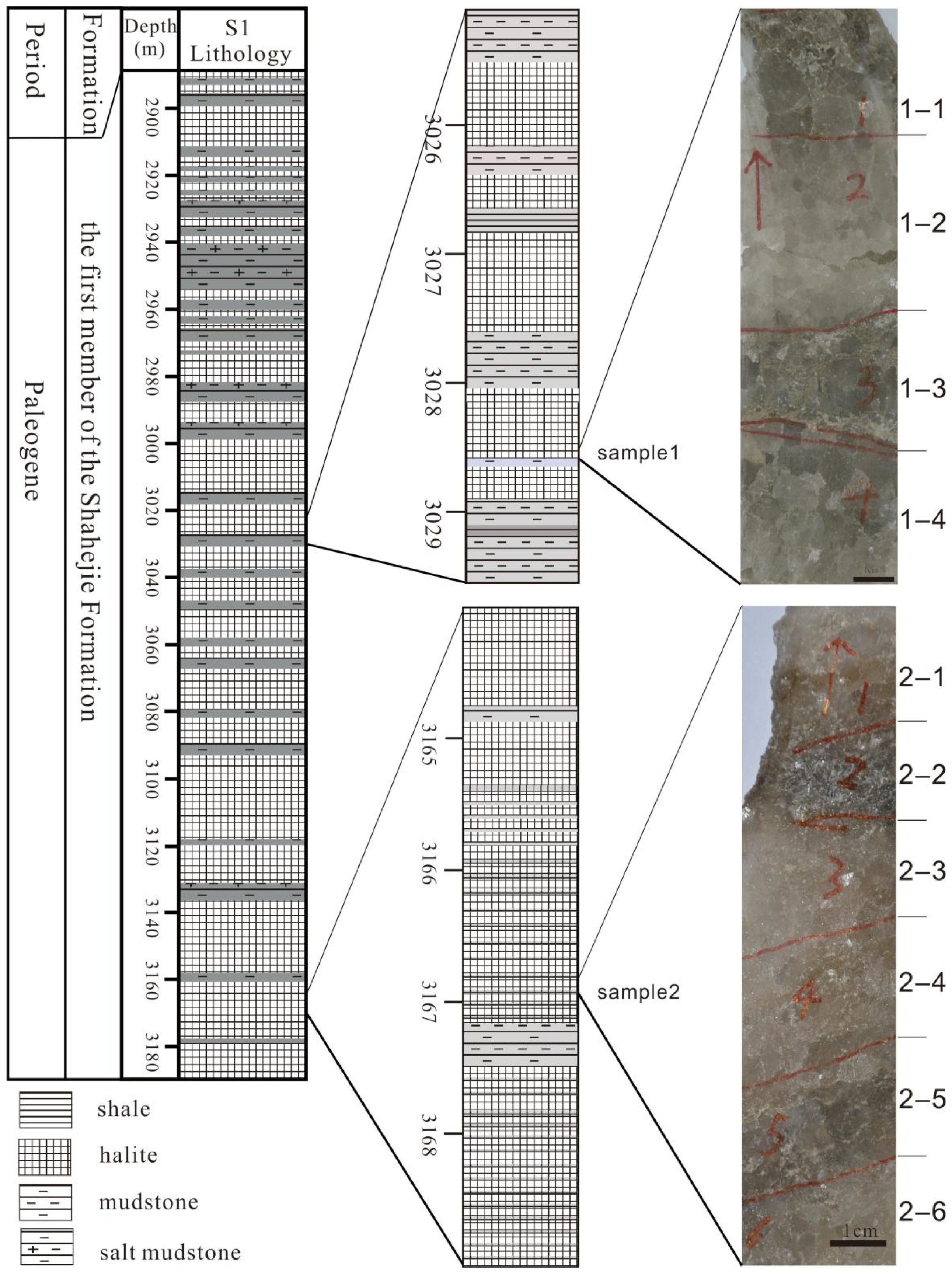


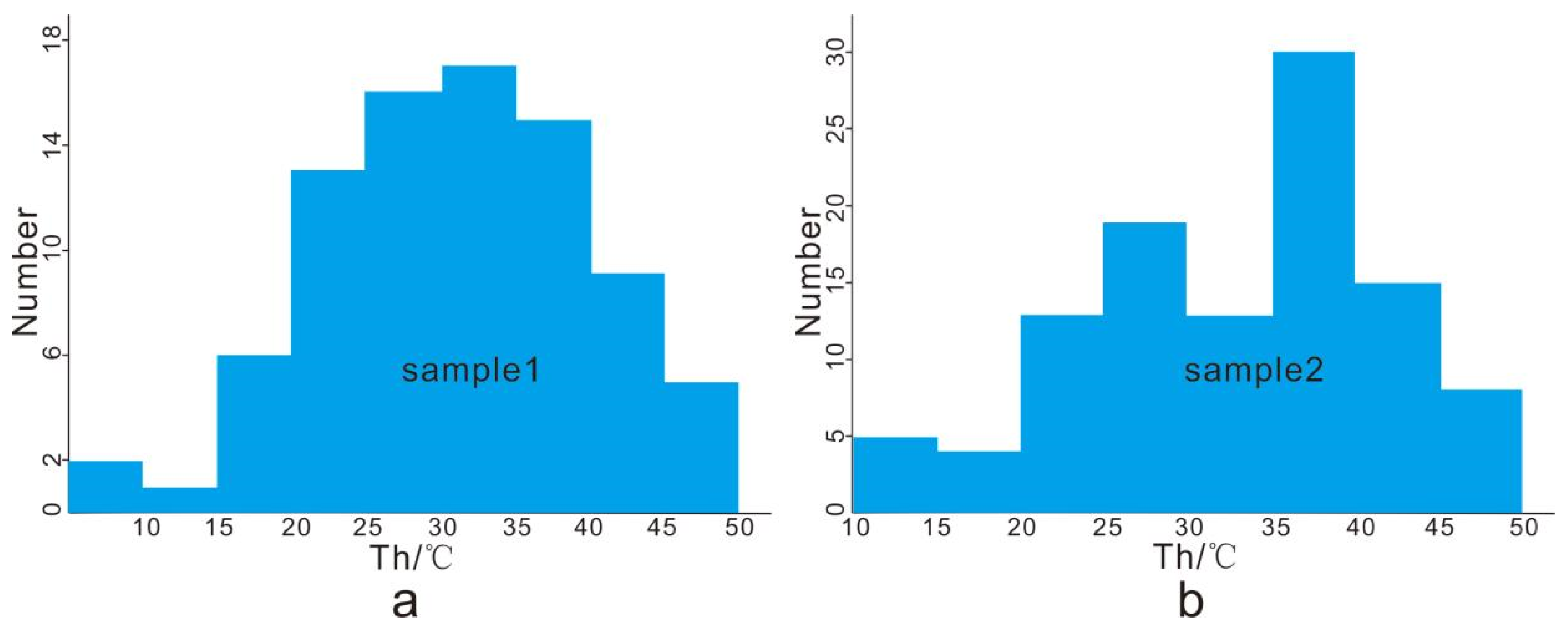
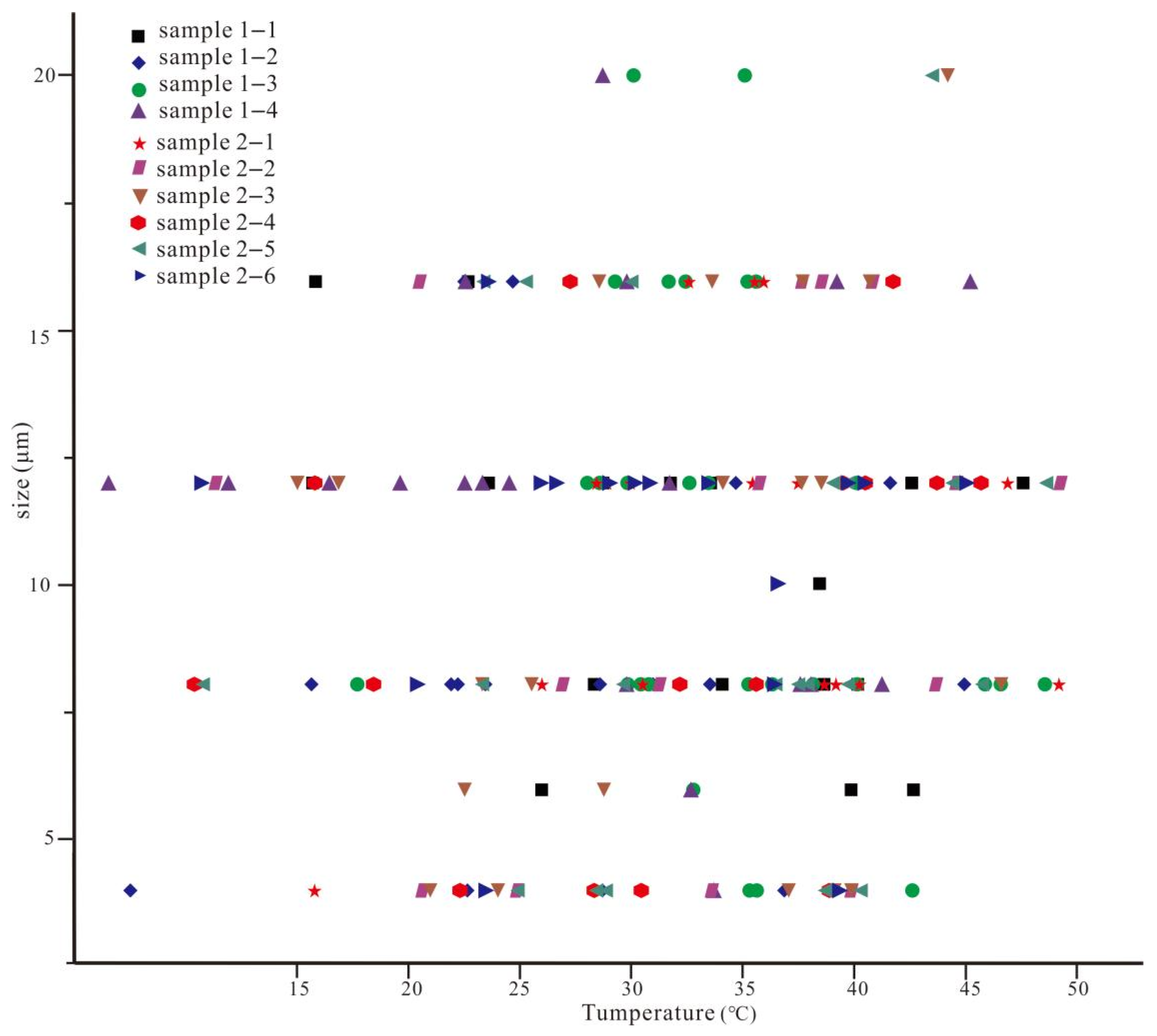
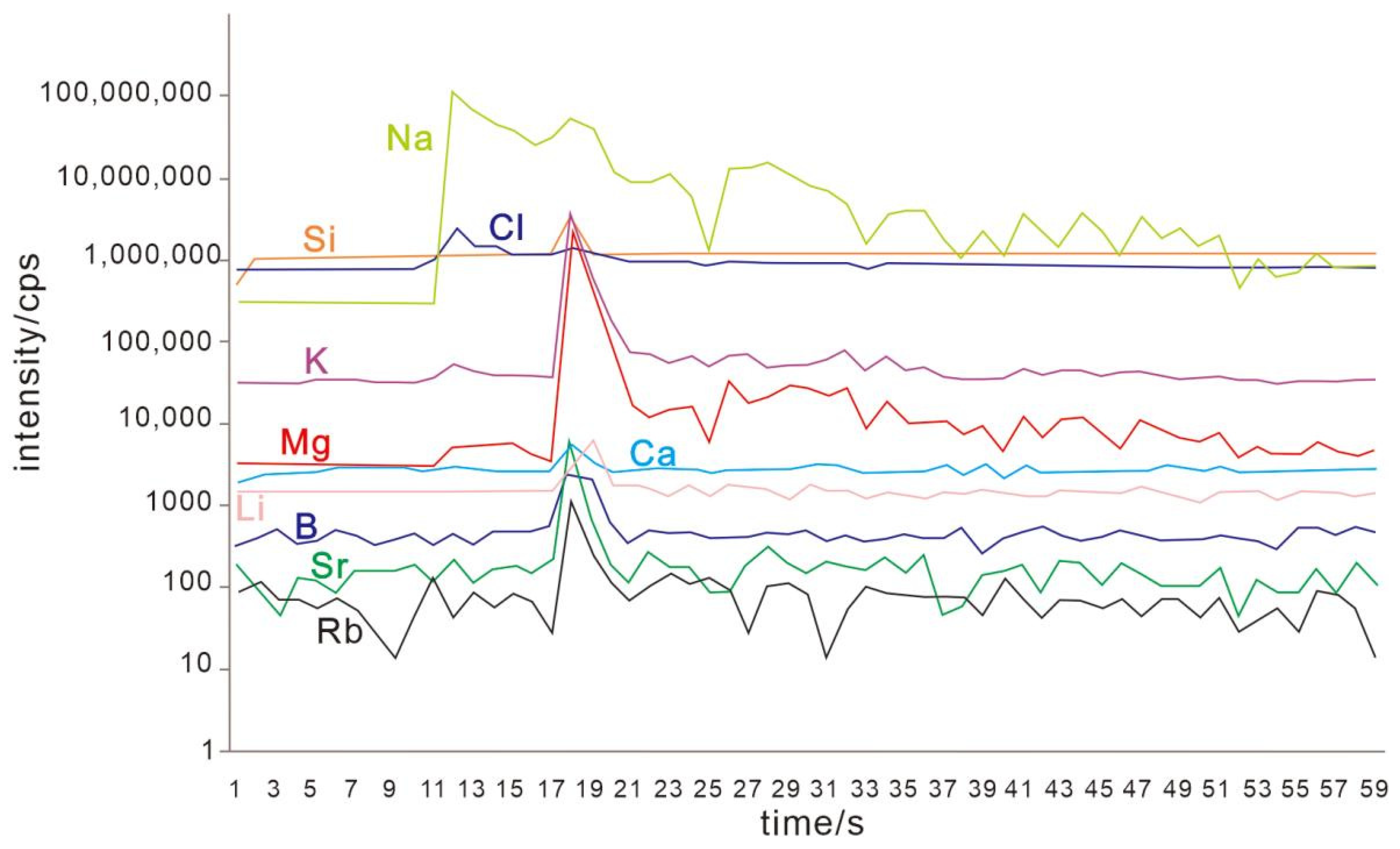
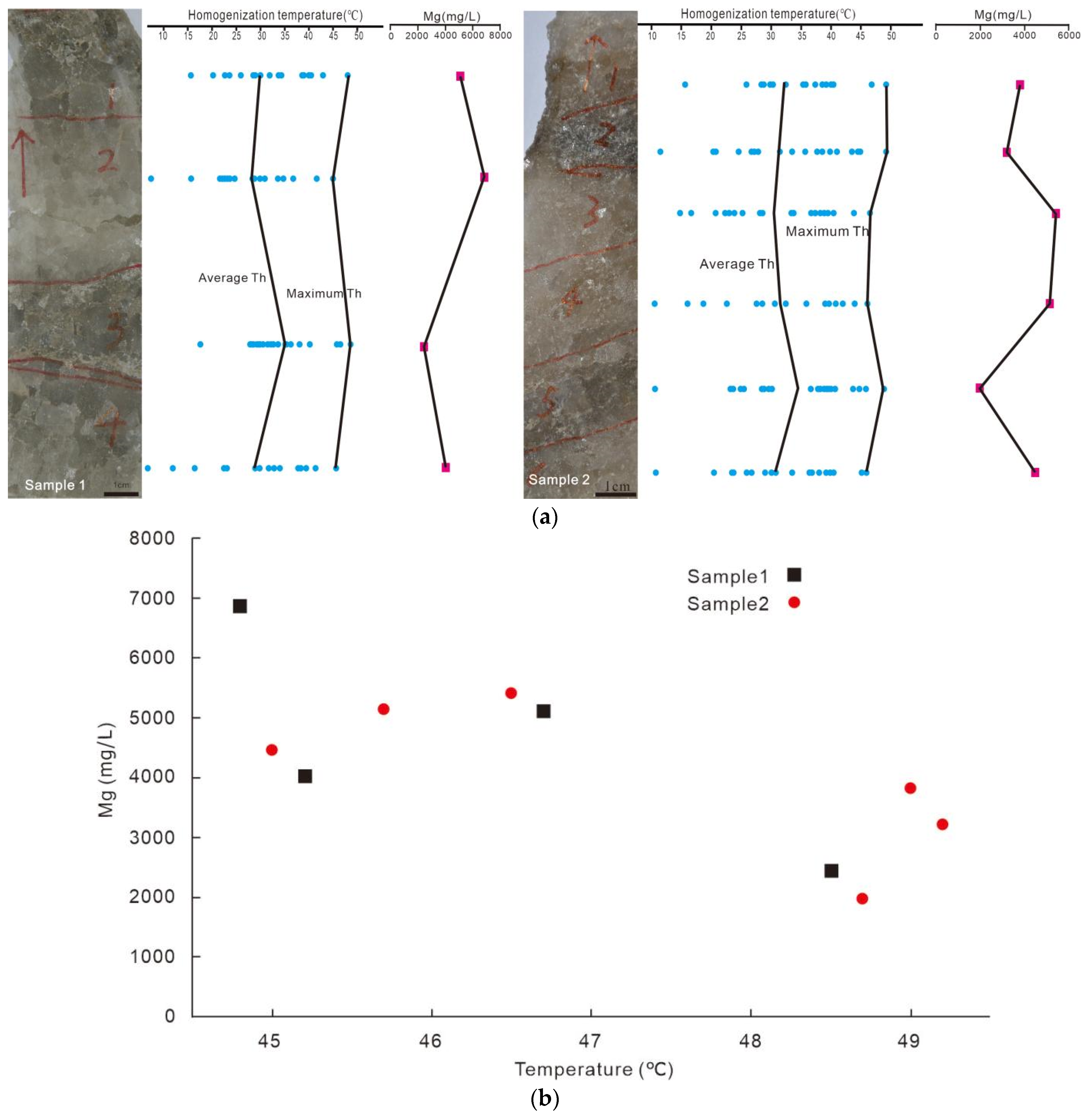
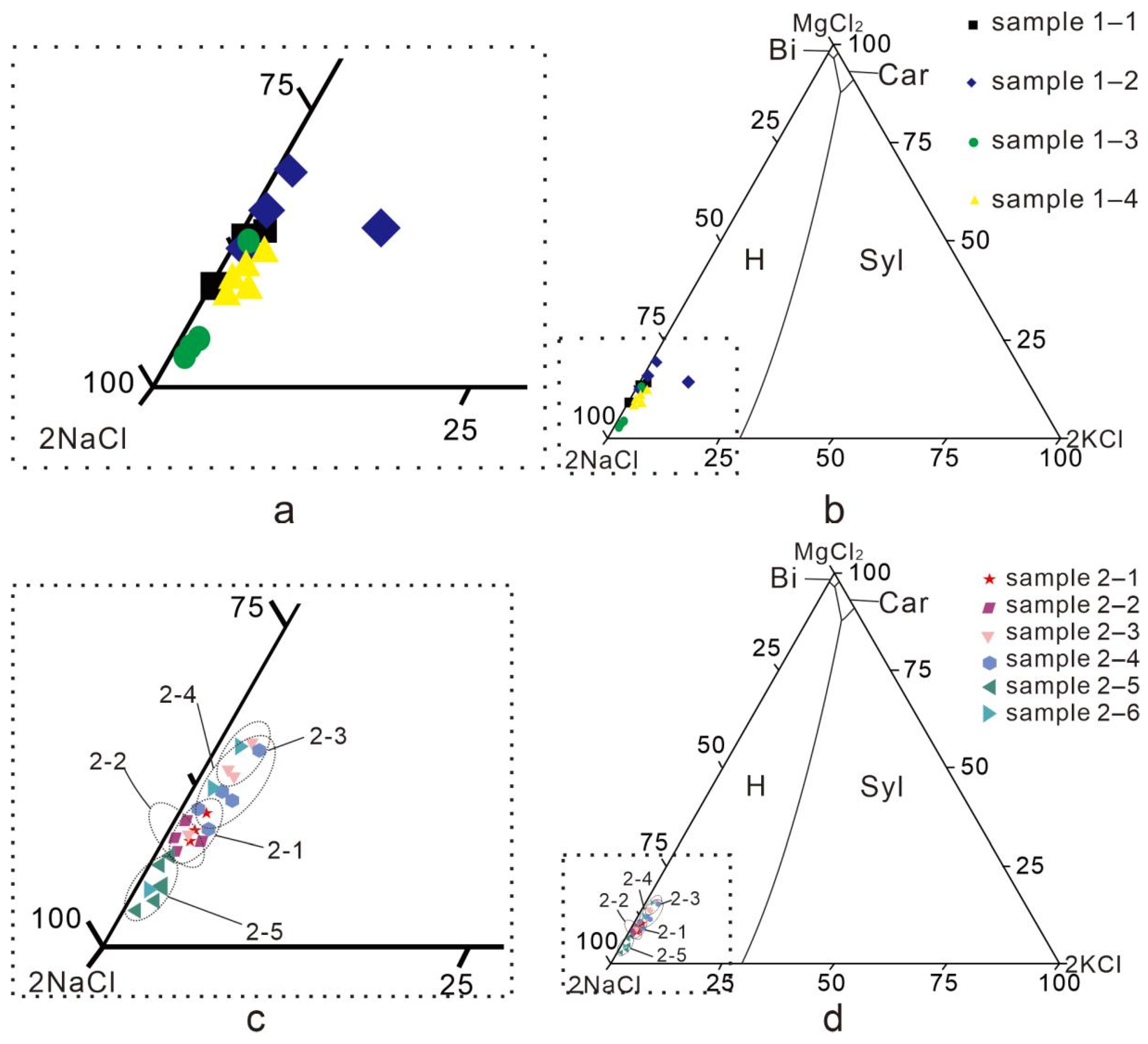
| Geological Time | Formation | Thickness (m) | Lithology |
|---|---|---|---|
| Oligocene | SF 1 | 0–800 | The lower part: red and black mudstone, carbonate, gypsum, argillaceous gypsum and salt rock. From north to south in the southern part of the depression, the lithology was marked by limestone–dolomite–gypsum–halite |
| The upper part: light grey fine sandstone, siltstone and amaranth mudstone | |||
| Eocene | SF 2 | 0–400 | interbedded brown, purple mudstone and light grey fine sandstone |
| SF 3 | 0–2200 | brown and grey breccia, breccia composed mainly of limestone or dolomite, brownish gray, grey mudstone, local shale and grayish fine sandstone in the upper | |
| SF 4 | 500–1000 | Clastic sediments mainly developed around the periphery of the basin, and mudstone sedimentary rocks and mud paste emerged in the center of the depression |
| Sample | Colour | Depth | Number | Thmin/°C | Thmax/°C | Thavg/°C | Thmed/°C |
|---|---|---|---|---|---|---|---|
| 1–1 | gray | 3028.68 | 19 | 15.6 | 46.7 | 31.5 | 31.7 |
| 1–2 | transparent | 3028.71 | 17 | 7.5 | 44.8 | 27.6 | 28.5 |
| 1–3 | gray | 3028.76 | 29 | 17.7 | 48.5 | 34.3 | 33.4 |
| 1–4 | transparent | 3028.00 | 19 | 6.5 | 45.2 | 28.1 | 29.8 |
| 2–1 | transparent | 3166.74 | 17 | 15.6 | 49 | 34.6 | 35.4 |
| 2–2 | gray | 3166.76 | 18 | 11.4 | 49.2 | 33.2 | 34.6 |
| 2–3 | transparent | 3166.78 | 20 | 14.9 | 46.5 | 31.5 | 33.7 |
| 2–4 | transparent | 3166.80 | 15 | 10.5 | 45.7 | 31.5 | 32.3 |
| 2–5 | gray | 3166.82 | 21 | 10.9 | 48.7 | 34.2 | 37.7 |
| 2–6 | transparent | 3166.84 | 16 | 10.6 | 45 | 30.6 | 30.4 |
| Sample | Number | Calculated Ion Concentrations (mg/L) | ||||||
|---|---|---|---|---|---|---|---|---|
| Li | B | Mg | K | Ca | Rb | Sr | ||
| 1–1 | 1-1-1 | 17.45 | 58.85 | 6011.28 | 2381.85 | 79.58 | 29.26 | 0.94 |
| 1-1-2 | 26.83 | 23.17 | 3623.64 | 210.32 | 20.44 | 6.58 | 0.19 | |
| 1-1-3 | 21.23 | 40.28 | 5712.64 | 469.37 | 26.53 | 26.27 | 0.41 | |
| 1–2 | 1-2-1 | 31.44 | 55.87 | 6838.97 | 945.69 | 194.95 | 51.12 | 1.36 |
| 1-2-2 | 32.67 | 71.79 | 8720.72 | 1163.01 | 152.44 | 37.70 | 1.38 | |
| 1-2-3 | 12.47 | 24.58 | 5083.92 | 776.69 | 77.29 | 44.40 | 0.78 | |
| 1-2-4 | 13.89 | 57.63 | 6842.48 | 15,692.79 | 89.18 | 86.84 | 1.76 | |
| 1–3 | 1-3-1 | 0.78 | 13.80 | 1604.96 | 913.73 | 42.00 | 11.15 | 0.23 |
| 1-3-2 | 12.15 | 16.91 | 1214.72 | 891.62 | 22.69 | 11.66 | 0.03 | |
| 1-3-3 | 9.35 | 16.54 | 1540.33 | 1084.72 | 46.52 | 5.71 | 0.08 | |
| 1-3-4 | 33.87 | 15.12 | 5429.28 | 457.36 | 123.31 | 18.11 | 1.06 | |
| 1–4 | 1-4-1 | 2.57 | 29.33 | 3642.54 | 2900.85 | 61.93 | 19.90 | 0.78 |
| 1-4-2 | 11.05 | 35.55 | 3604.63 | 2324.01 | 37.41 | 18.65 | 0.76 | |
| 1-4-3 | 17.06 | 50.79 | 5119.33 | 3256.74 | 120.57 | 37.64 | 0.76 | |
| 1-4-4 | 5.39 | 29.34 | 3775.27 | 1476.22 | 43.93 | 10.67 | 0.43 | |
| 1-4-5 | 12.30 | 43.31 | 4030.13 | 1816.78 | 69.25 | 21.49 | 0.64 | |
| Sample | Number | Calculated Ion Concentrations (mg/L) | ||||||
|---|---|---|---|---|---|---|---|---|
| Li | B | Mg | K | Ca | Rb | Sr | ||
| 2–1 | 2-1-1 | 26.31 | 7.32 | 3333.70 | 1680.41 | 187.14 | 9.23 | 3.82 |
| 2-1-2 | 0.70 | 27.47 | 3770.25 | 2034.66 | 74.63 | 9.01 | 2.34 | |
| 2-1-3 | 3.81 | 24.77 | 4374.57 | 1716.70 | 313.30 | 15.55 | 3.96 | |
| 2–2 | 2-2-1 | 21.00 | 33.42 | 3853.14 | 956.91 | 51.60 | 4.86 | 1.26 |
| 2-2-2 | 47.45 | 36.46 | 3701.09 | 1113.07 | 147.02 | 3.34 | 1.01 | |
| 2-2-3 | 0.40 | 5.61 | 2450.28 | 1868.62 | 208.14 | 12.90 | 4.90 | |
| 2-2-4 | 28.48 | 17.80 | 2826.30 | 1031.29 | 92.74 | 3.51 | 1.19 | |
| 2–3 | 2-3-1 | 26.56 | 23.84 | 3337.34 | 1196.46 | 158.47 | 5.41 | 2.89 |
| 2-3-2 | 39.91 | 18.37 | 5713.76 | 970.13 | 51.52 | 5.41 | 1.65 | |
| 2-3-3 | 0.30 | 20.69 | 5617.26 | 2337.89 | 584.68 | 9.05 | 2.34 | |
| 2-3-4 | 26.88 | 19.64 | 6996.68 | 2942.81 | 192.79 | 19.71 | 4.66 | |
| 2–4 | 2-4-1 | 2.06 | 10.18 | 4334.51 | 1339.71 | 127.12 | 10.25 | 1.97 |
| 2-4-2 | 58.56 | 33.79 | 6791.65 | 4163.23 | 192.29 | 18.46 | 3.87 | |
| 2-4-3 | 42.65 | 18.26 | 4499.81 | 1495.59 | 62.86 | 4.41 | 1.25 | |
| 2-4-4 | 15.42 | 13.20 | 4971.70 | 2851.68 | 185.88 | 14.96 | 1.99 | |
| 2–5 | 2-5-1 | 61.49 | - | 1481.70 | 2358.38 | 127.04 | 22.41 | 6.74 |
| 2-5-2 | - | - | 1036.36 | 934.26 | 135.50 | 13.67 | 4.60 | |
| 2-5-3 | 63.04 | 24.10 | 2286.72 | 868.50 | 75.70 | 3.34 | 1.07 | |
| 2-5-4 | 52.85 | 21.82 | 2420.97 | 567.44 | 76.18 | 13.70 | 1.88 | |
| 2-5-5 | 31.78 | 18.43 | 2712.10 | 1070.32 | 74.56 | 3.73 | 1.23 | |
| 2–6 | 2-6-1 | 32.82 | 380.30 | 6598.26 | 1628.37 | 57.54 | 5.50 | 1.15 |
| 2-6-2 | 97.13 | 39.89 | 5075.22 | 1297.82 | 156.43 | 7.50 | 2.18 | |
| 2-6-3 | 25.14 | 8.07 | 1698.95 | 988.36 | 131.91 | 6.24 | 1.82 | |
Publisher’s Note: MDPI stays neutral with regard to jurisdictional claims in published maps and institutional affiliations. |
© 2022 by the authors. Licensee MDPI, Basel, Switzerland. This article is an open access article distributed under the terms and conditions of the Creative Commons Attribution (CC BY) license (https://creativecommons.org/licenses/by/4.0/).
Share and Cite
Zhao, X.; Zhao, Y.; Wang, M.; Hu, Y.; Liu, C.; Zhang, H. Estimation of the Ambient Temperatures during the Crystallization of Halite in the Oligocene Salt Deposit in the Shulu Sag, Bohaiwan Basin, China. Minerals 2022, 12, 410. https://doi.org/10.3390/min12040410
Zhao X, Zhao Y, Wang M, Hu Y, Liu C, Zhang H. Estimation of the Ambient Temperatures during the Crystallization of Halite in the Oligocene Salt Deposit in the Shulu Sag, Bohaiwan Basin, China. Minerals. 2022; 12(4):410. https://doi.org/10.3390/min12040410
Chicago/Turabian StyleZhao, Xianfu, Yanjun Zhao, Mingquan Wang, Yufei Hu, Chenglin Liu, and Hua Zhang. 2022. "Estimation of the Ambient Temperatures during the Crystallization of Halite in the Oligocene Salt Deposit in the Shulu Sag, Bohaiwan Basin, China" Minerals 12, no. 4: 410. https://doi.org/10.3390/min12040410
APA StyleZhao, X., Zhao, Y., Wang, M., Hu, Y., Liu, C., & Zhang, H. (2022). Estimation of the Ambient Temperatures during the Crystallization of Halite in the Oligocene Salt Deposit in the Shulu Sag, Bohaiwan Basin, China. Minerals, 12(4), 410. https://doi.org/10.3390/min12040410







